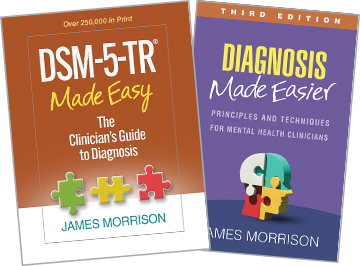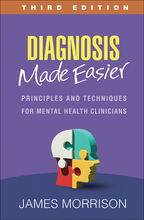Diagnosis Made Easier
Third Edition
Principles and Techniques for Mental Health Clinicians
James Morrison

New to This Edition
- Revised throughout for DSM-5-TR, including the new diagnosis of prolonged grief disorder.
- Chapter on eating and sleeping disorders, including new decision trees.
- New and updated vignettes and suggested readings.
“A useful resource for clinicians to learn a systematic approach for arriving at diagnoses....Appropriate for students and those in early postgraduate training, as well as more experienced clinicians endeavoring to teach this material.”
—Psychiatric Services (on the first edition)
“This book pulled me in, because it is different than most other books on diagnosis, it fills a niche, and the writing style is marvelous....Morrison adopts the role of a friendly tutor, one who has a wealth of clinical experience but assumes that some readers are new to this and that some seasoned clinicians were trained poorly or have developed bad habits that interfere with their capacity to reliably diagnose patients with precision. He writes in a style that is both scientific and professional, but also conversational....This book would be of value to students in training, as the basis for a course on diagnostics, or as a reference honing the skills of experienced clinicians, which is exactly how I used it. This is an exceptional book that must be read and reread because of the wealth of information it contains.”
—PsycCRITIQUES (on the first edition)
“Morrison lays out the principles of the diagnostic process and their application to common clinical challenges, such as concurrent psychiatric and general medical comorbidities. Extraordinarily useful chapters engage the reader in the application of diagnostic principles and building blocks to a wide range of discerningly presented clinical cases. Now more than ever, as health care systems inappropriately substitute symptom checklists for actual diagnoses, the risk of errors is substantial. Mental health professionals must understand and apply diagnostic processes to recognize when a revised diagnosis or second opinion is called for. This is the best book I have ever seen that addresses this critical need. Please buy and use this third edition—we owe it to ourselves and our patients to get it right.”
—A. John Rush, MD, ABPN, Duke Medical School; National University of Singapore (Emeritus)
“The third edition of Diagnosis Made Easier retains everything that has made this book such a trusted resource, while incorporating comprehensive updates for DSM-5-TR. This book discusses core principles of diagnosis as well as how to apply these principles across a wide range of problems. Morrison combines clear writing, cutting-edge content, and abundant illustrative examples drawn from clinical practice and popular culture.”
—Martin M. Antony, PhD, ABPP, Department of Psychology, Toronto Metropolitan University, Canada
“An intuitive and indispensable resource. With clarity and precision, Morrison uses vignettes and practical examples to elucidate the complexities of psychiatric diagnosis. Beyond the technical aspects of diagnosis, the book emphasizes the significance of compassionate care, effective communication, and collaborative decision making. Leveraging his wealth of clinical expertise and meticulous approach to diagnosis, Morrison establishes this third edition as an essential guide for health care professionals.”
—David H. Klemanski, PsyD, MPH, Department of Psychiatry, Yale University
“This book presents the art of diagnosis in a logical framework, and has been updated for DSM-5-TR. Morrison presents multiple case examples and uses flow charts to lead clinicians to the appropriate diagnosis or diagnoses, so they can formulate effective treatment plans. I particularly enjoyed the scholarly and historical tidbits that are liberally sprinkled throughout the chapters. I recommend this wonderful, clearly written guide to trainees in mental health fields, as well as established practitioners.”
—David L. Dunner, MD, FACPsych, Director, Center for Anxiety and Depression, Mercer Island, Washington
Table of Contents
IntroductionI. The Basics of Diagnosis
1. The Road to Diagnosis
2. Getting Started with the Roadmap
3. The Diagnostic Method
5. Coping with Uncertainty
6. Multiple Diagnoses
7. Checking Up
II. The Building Blocks of Diagnosis
8. Understanding the Whole Patient
9. Physical Illness and Mental Diagnosis
10. Diagnosis and the Mental Status Examination
III. Applying the Diagnostic Techniques
11. Diagnosing Depression and Mania
12. Diagnosing Anxiety, Fear, Obsessions, and Worry
13. Diagnosing Psychosis
14. Diagnosing Problems of Memory and Thinking
15. Diagnosing Substance Use and Other Addictions
16. Diagnosing Eating and Sleeping Disorders
17. Diagnosing Personality and Relationship Problems
18. Beyond Diagnosis: Compliance, Suicide, Violence
19. Patients, Patients
Appendix: Diagnostic Principles
References and Suggested Readings
Index
About the Author
James Morrison, MD, is Affiliate Professor of Psychiatry at Oregon Health and Science University in Portland. His long career includes extensive experience in both the private and public sectors. With his acclaimed practical books—including DSM-5-TR Made Easy;- All titles by James Morrison
- Sign up for emails on upcoming titles by James Morrison (with special discounts)!
Audience
Psychiatrists, clinical psychologists, clinical social workers, psychiatric nurses, and counselors working with adults; graduate students and residents.Course Use
Serves as a text in graduate-level courses that deal with psychiatric diagnosis.
 Special package offer:
DSM-5-TR® Made Easy: The Clinician's Guide to Diagnosis explains DSM diagnoses in clear language, illustrated with vivid case vignettes.
Special package offer:
DSM-5-TR® Made Easy: The Clinician's Guide to Diagnosis explains DSM diagnoses in clear language, illustrated with vivid case vignettes.
Order both items for $89.95, instead of $129.00 if bought separately!
order package
Previous editions published by Guilford:
Second Edition, © 2014
ISBN: 9781462529841
First Edition, © 2007
ISBN: 9781593853310
New to this edition:
- Revised throughout for DSM-5-TR, including the new diagnosis of prolonged grief disorder.
- Chapter on eating and sleeping disorders, including new decision trees.
- New and updated vignettes and suggested readings.

